Research Reports/ Rapports De Recherche
Woollen Blankets in Contemporary Art:
Mutable and Mobile Materials in the Work of Sonny Assu
1 Since the mid-1980s, woollen blankets (like the one seen in Fig. 1) have become increasingly visible and manifest in works of art by contemporary artists in Canada, the United States, and in Aotearoa New Zealand. Made from raw wool that is washed, dyed, carded and fulled, the woollen blankets discussed in this research report have a history of production that dates back to around the 17th century in the United Kingdom. 1 Throughout their history of manufacture, these woollen blankets have varied in size, colour, and patterning, but historically they have tended to have a monochromatic field: grey, deep navy blue, or white with either dark indigo bands, or multi-coloured stripes of red, blue, green and purple at either end of the blanket (McDonald 2006). 2 The more popular version of these woollen blankets in North America is known as the Hudson’s Bay Company Point blanket, and they were originally produced by Witney Mills in Oxfordshire, England, as early as the late 1600s (Anon. 1938; Hanson 1973; MacKay 1935; Rex 1958). These woollen blankets are further recognizable by either the dark indigo or coloured bands at the top and bottom edges of the woollen blanket, as well as small lines (or point markings) that are intended to denote the size and/or quality of each blanket. Since the late 19th and early 20th centuries, the presence of woollen blankets increased on the market with different colours, patterns and qualities beginning to emerge as weaving mills were technologically enhanced and eventually established in settler states in Canada, the U.S. and Aotearoa New Zealand. Each mill, whether in the U.K. or abroad, possessed (or still possesses) a signature style for their blankets that is often defined by a distinct range of colours, markings, labels and patterns. While the woollen blankets were/are signature products of their respective mill, generally speaking, the woollen mills in both North America and in the Antipodes operated on technology that emerged during the mechanization of the woollen blanket industry in the U.K., which was spurred on by the Industrial Revolution, and such technology meant that any mill could produce an array of woollen blankets. These blankets are now appearing in contemporary art, craft and design and have been used in indigenous regalia for more than two centuries.
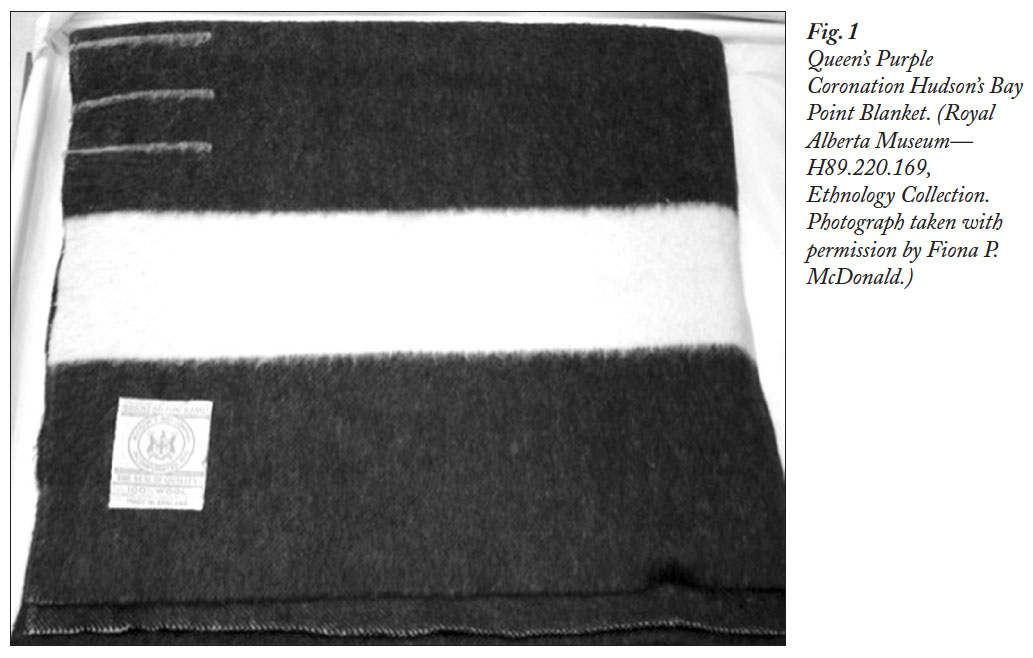 Display large image of Figure 1
Display large image of Figure 12 But beyond the history of the manufacture of woollen blankets, my report poses the question: what does the increased presence of woollen blankets in contemporary art illuminate about the broader historical manufacturing, movement and gesticulations of this object across time and space? This question is only a miniscule extraction from a larger doctoral research project that involves the voices and works of many influential artists today and is central to my multi-sited visual and material ethnography of woollen blankets in contemporary art, craft, design and indigenous regalia from an anthropological perspective. Here I will present one case study from this larger research project to discuss the work of Sonny Assu. Assu’s work is presented here in order to trace out his presentation of the movements of woollen blankets into North America from the United Kingdom as part of the fur trade industry through his personal experience with this material object and his art. To clarify, the history of woollen blankets moving from their site of manufacture in the U.K. to settler states such as Canada, the U.S. and Aotearoa New Zealand is particularly dense, multi-perspectival and complex, and so to attempt to fully tackle the diverse gesticulations of woollen blankets in this brief research discussion would be impossible. Instead, I will enter the conversation about the history and use of woollen blankets through the context of Sonny Assu’s art so that the movement of woollen blankets from their production in the U.K. to their passage into contemporary art within North America becomes visible from the perspective of one artist.
3 There have been several influential artists like Sonny Assu working with woollen blankets over the past thirty years in both North America and the Antipodes: Bill Powless (Beach Blanket Brave, 1984); Bob Boyer (Blanket Statements, 1985); Alan Michelson (Up-Biblem God, 1987); Ron Nogonosh (That’s All it Costs, 1991); Jim Logan (Olympian, 1991); Jolene Rickard (I See Red in ’92, 1992); Marianne Coreless (a numbered series of woollen blankets made from fur entitled Blanket, 2002); Marie Watt (several works produced using recycled woollen blankets, including Blanket Stories: Three Sisters, Cousin Rose, Four Pelts, and Sky Woman, 2005; Skywalker/ Skyscraper, 2012; and Welcome Pole, 2013); Liz Magor (Hudson’s Bay Double and several others, 2011); and Leah Decter ([Official Denial] Trade Value in Progress, 2011). 3 It is important to stress that these are not the only artists whose works either incorporate the woollen blanket present a visual interpretation of the woollen blanket, but, independently, each aforementioned artist offers a unique perspective on the woollen blanket and its histories, and each fundamentally represents the different ways in which woollen blankets have been moved into the gallery—an act critical to the production of new knowledge around material culture. Assu’s works, as one case study, provide an insightful glimpse into my larger research project that attempts to chart how artistic engagement with the woollen blanket makes visible some of the pre-gallery, historical contexts of the woollen blanket, as well as the social relations that have variously coalesced around a single material object (Gell 1998; McDonald 2014). Taking inspiration from a past issue of Material Culture Review/Revue de la culture matérielle on the theme of “Objects in Motion,” this report looks at how one artist has set an object—the woollen blanket—in motion through his art. Again, it is important to stress that the work of Assu’s use of the woollen blanket captures only oneperspective and voice from a larger anthropological investigation of woollen blankets that is attempting to unpack the dynamism of this material object (McDonald 2014). Assu’s work is a particularly useful case study here because he mobilizes not only the material object but also representations of the blanket in various ways, as I will share below.
Case Study: Sonny Assu
4 Sonny Assu (b. 1975), a contemporary interdisciplinary artist currently based in Montréal, Canada, is well regarded for his use of prominent signs and symbols such as the Coca-Cola logo and Hudson’s Bay Company Point blanket. Assu’s perspective on his own work is that it involves merging “indigenous iconography with the aesthetics of popular culture to challenge the social and historical values placed upon both” (Assu 2012). Assu, who is Lig_wilda’x_w (Kwakwa_ka_’wakw) of the We Wai Kai First Nation (Cape Mudge), consciously engages with materials that, for him, have histories and could subsequently be called “storied objects.” 4 In selecting to incorporate either woollen blankets or representations of woollen blankets that are often associated with the Hudson’s Bay Trading Company into his work, Assu participates not only in literally moving the woollen blanket itself, but also in creating a new context for experiencing the woollen blanket, which he derives from the object’s histories beyond the gallery space. In particular, the role of the woollen blanket in the Canadian fur trade industry comes to the forefront. 5
5 Historians and anthropologists have widely acknowledged that woollen blankets were considered valuable commodities sent out as trade goods with colonial missions to various settler states. When looked at critically and specifically as objects present within a colonial context, wool-len blankets were gifted, bartered, traded and exchanged with indigenous peoples in Canada, the U.S. and Aotearoa New Zealand. Woollen blankets that were not sent overseas, however, had their own presence within the domestic sphere of homes dotted across England, Scotland, Wales and Ireland. The general movement of woollen blankets overseas during the expansion of the British Empire has also been documented quite extensively in colonial visual culture and archival records around the world. The many places to which woollen blankets have been transported can be found in a range of visual and oral cultures beyond the woollen mills in the U.K. For example, woollen blankets have appeared in the numerous visual representations from the colonial trade era that discretely document the woollen blanket’s movement into different landscapes and cultures. In Canada, works by Paul Kane (1810-1871) and Cornelius Kreighoff (1815-1872) 6 capture how traders, missionaries and explorers moved woollen blankets throughout the vast landscape of Canada from Hudson’s Bay inland across the prairies and along to the Pacific Northwest Coast (Swagerty 2002). I would argue that of all commodities produced in the U.K. destined for export at the height of the U.K.’s colonial ambition, Assu has selected one object that has continued to “enchant” 7 wherever it touched down (Gell 1998: 163).
6 By either incorporating the woollen blanket directly or using a visual representation of a woollen blanket, Assu moves this object into our field of vision in a very specific way. Through his multimedia sculptural works that will be explored in detail below, Assu addresses past movements and uses of woollen blankets within his own First Nations community’s byway of trade interactions, subsequently highlighting the role of woollen blankets in potlatch ceremonies as documented in the oral traditions of indigenous communities along the Pacific Northwest Coast. Assu’s work entitled 1884-1951/Disposable Wealth (Fig. 2) was first exhibited in 2009 at the Vancouver Art Gallery in an exhibition called How Soon is Now?. During the exhibition, 1884-1951 was not displayed with a woollen blanket, but one year later, in his self-titled solo exhibition, Sonny Assu, at Equinox Gallery (Vancouver), in 1884-1951, Assu used a Hudson’s Bay Company Point blanket upon which sixty-seven large copper-cast coffee cups rested. 8 This blanket has been featured in subsequent installations of this work. In it, the woollen blanket functions structurally as a plinth but its presence in this work is used to activate various histories and meanings both visible and invisible. The specific woollen blanket Assu uses in his work, a four-point maroon blanket, is rare. According to Assu, he purchased it on eBay (year and provenance unknown) (Sonny Assu, personal communication, December 12, 2012). 9
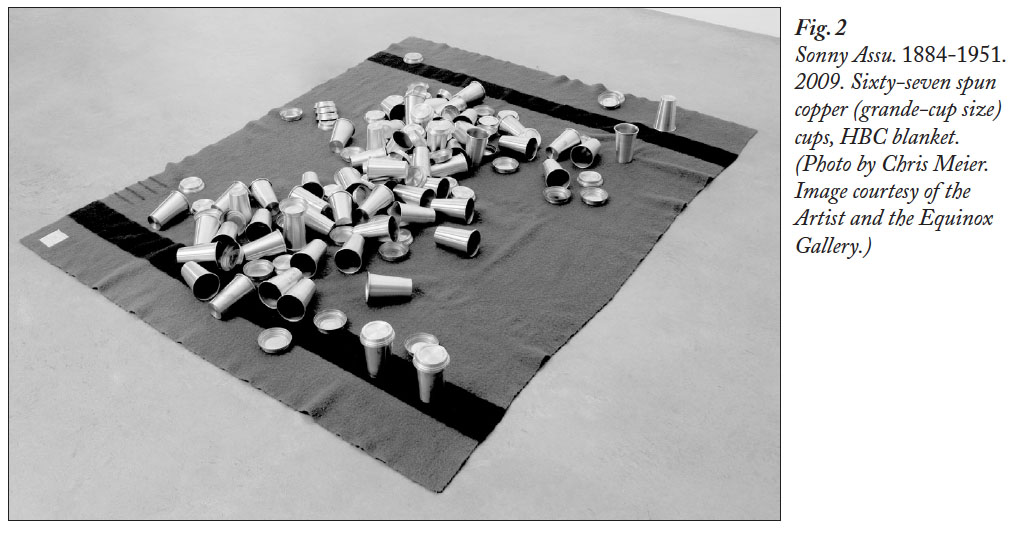 Display large image of Figure 2
Display large image of Figure 27 Assu’s placement of a woollen blanket into his work within the gallery re-addresses one of the first historical movements of blankets out of the U.K. and into Assu’s own First Nation community. From this historical trajectory of production and distribution, Assu’s considered use of other materials, such as copper, also contextualizes the historical use of non-indigenous material culture within indigenous ceremonial contexts. By shaping copper into the form of coffee cups, Assu reinforces one’s awareness of how objects do not exist in isolation but rather have flowed through time and space into shared contexts. One shared space beyond the gallery where woollen blankets and copper have co-existed is within the potlatch 10 ceremony practised in First Nations communities along the Pacific Northwest Coast. Material goods like copper, blankets, trade cloth and foodstuff were collected by one clan and distributed to another clan as tokens of gratitude and signs of wealth during ceremonies. 11 The inclusion of copper in the shape of a Starbucks grande-sized coffee cup is a comment upon the shifting evaluation of wealth in society today.
8 Symbolically, each copper cup that rests on the woollen blanket represents one year for which the ceremonial event known more popularly as the “potlatch” along the Pacific Northwest was officially banned in Canada—sixty-seven years in total (1884-1951). This ban resulted from an amendment to the Indian Act in Canada that deemed potlatching illegal. 12 Fines were levied and sometimes prison sentences were issued against those considered “violators” of the Indian Act for participating in their cultural ceremonies:
9 In Assu’s work, then, woollen blankets and copper in traditional Kwakawa_ka_’wakw ceremonies play a significant role in the tradition of the potlatch and are brought together here in the context of art. Assu allows audiences to access the multiplicity of history through the material of woollen blankets and copper in a way that makes a connection between theories of consumption and awareness of social symbols of wealth (Miller 2005a, 2005b). In conversation with Anne Cottingham, Assu said that when he “spoke to people during it’s [sic] installation at the VAG [Vancouver Art Gallery], many said they didn’t know that the ban had lasted that long, or even that it had happened so recently” (qtd. in Cottingham 2011). According to Assu, the woollen blanket was “a tool of trade, which then became a tool of oppression[,] which then became a tool of genocide” (qtd. in Cottingham 2011). In placing the woollen blanket into public visibility through artwork, Assu encourages people to be aware of its history and other material associations through the strategic use of material culture that has become densely entangled with mnemonic cues. Assu states:
Under the potlatch ban, any participation in the indigenous ceremonial event was strictly prohibited. This prohibition thus denied First Nations peoples the ability to practise their way of life and was intended to halt all engagement with many critical engagements with their material culture (masks, regalia, etc.) that were both produced within their community and introduced through trade with non-indigenous communities (Glass 2006; Masco 1995). During this sixty-seven year ban, traditional indigenous cultural items used in ceremony were often confiscated, and some objects moved from First Nations communities into public and private collections around the world. Regalia made on woollen blankets were among some of them.
10 In his works that predate 1884-1951/ Disposable Wealth, Assu also used the woollen blanket to draw attention to yet another distinct use of woollen blankets in his culture—the use of blankets for regalia. In his works entitled Death Blanket (2006) and The Great Appropriator Embrace (2003), he references not only the potlatch ban but also the use of woollen blankets in the making of traditional ceremonial regalia known as the button blanket robes. Button blanket robes have historically been made in indigenous communities along the Pacific Northwest Coast using navy Hudson’s Bay Company woollen blankets embellished with mother of pearl and abalone shell buttons that outline clan crests and sacred heraldic images. By bringing this post-contact Western material into indigenous regalia, and then repositioning it as a work of art in the gallery, Assu offers an interpretation of button blanket robes that also references the appropriation of culture and materials and the incidences of cultural death associated with cultural contact. In Death Blanket, for example, Assu replaces a clan crest with buttons that trace out the outline of a skull. Assu notes, “The HBC blankets were also used to spread small pox and tuberculosis amongst the First People to aid in the act of genocide western society would rather forget” (qtd. in Baxley 2011). 13 In these three works alone, Assu has mobilized the woollen blanket as a way to activate history and the complexity of objects within various contexts from his community to the shifting values within artwork in the gallery.
11 More recently, Assu’s sculptural works have also moved in the direction of visual representations of the woollen blanket. In the series entitled Silenced, drums evoke images of stacked woollen blankets, signalled with the signature dark band and small point markings painted on the drums— the woollen blankets become the drums, and the drums the blankets (Figs. 3-5). Both objects— woollen blankets and drums—make reference to the role of specific materials in First Nations culture and the repression of their rights to practise their culture. In the act of stacking drums, Assu makes an explicit reference to the stacks of blankets that were prepared prior to potlatch ceremonies: the blanket was considered an item of wealth and was distributed to guests during the ceremony. Assu is also referencing other visual representations of stacked blankets that emerged from the documentary work of photographers and anthropologists who conducted ethnographic fieldwork along the Pacific Northwest Coast. As seen in the archival image from the Hudson’s Bay Company Archives (HBCA) (Fig. 6), one of many examples of such photographs, woollen blankets are seen piled high and deep for their eventual distribution at a potlatch ceremony in a Haida community. Therefore, Assu’s “visual quotation” (to borrow a phrase from Patricia Vervoort) of stacked woollen blankets emerges from both ethnographic photographs and oral traditions that commemorate momentous ceremonies of this significant traditional practice not only in Assu’s Kwakwa_ka_’wakw community of the We Wai Kai First Nation (Cape Mudge), but along the Pacific Northwest Coast in many First Nations communities (Vervoort 2004: 469).
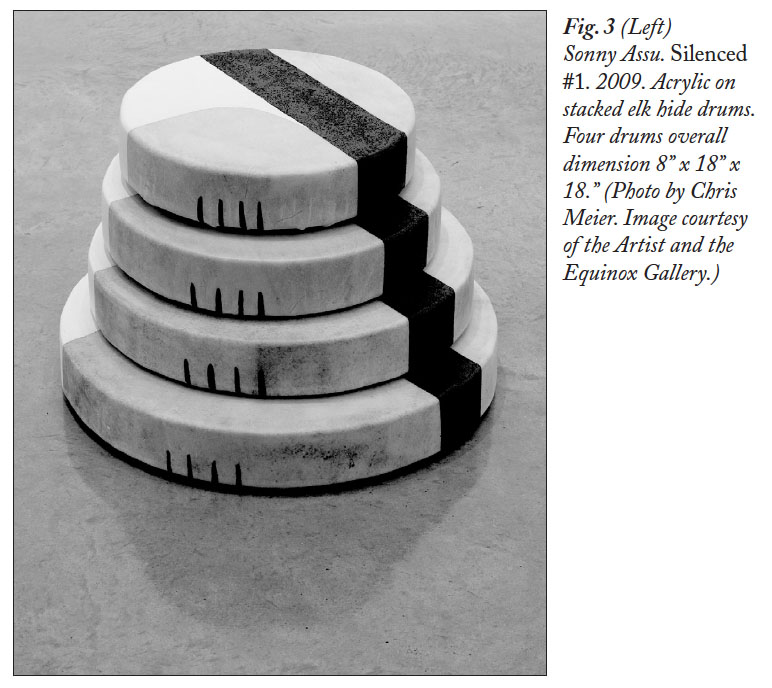 Display large image of Figure 3
Display large image of Figure 3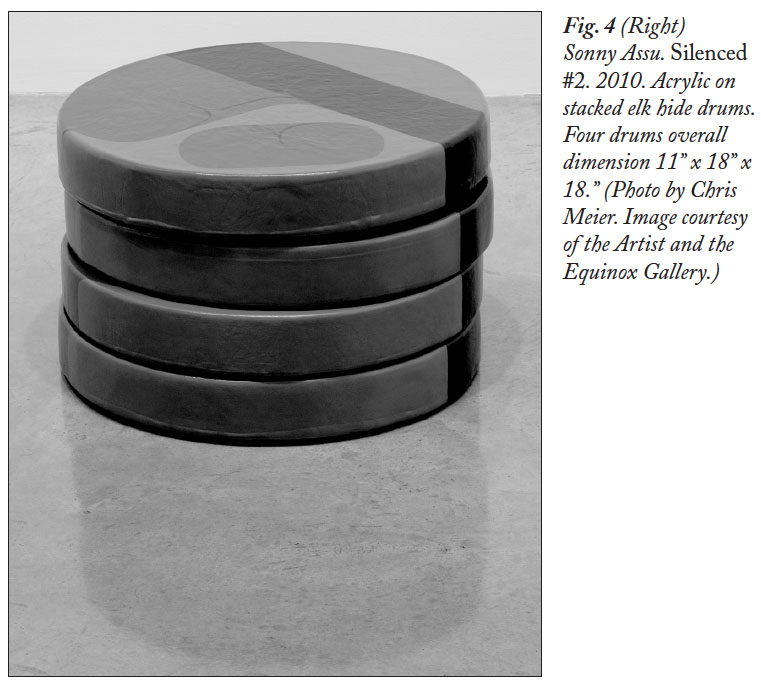 Display large image of Figure 4
Display large image of Figure 4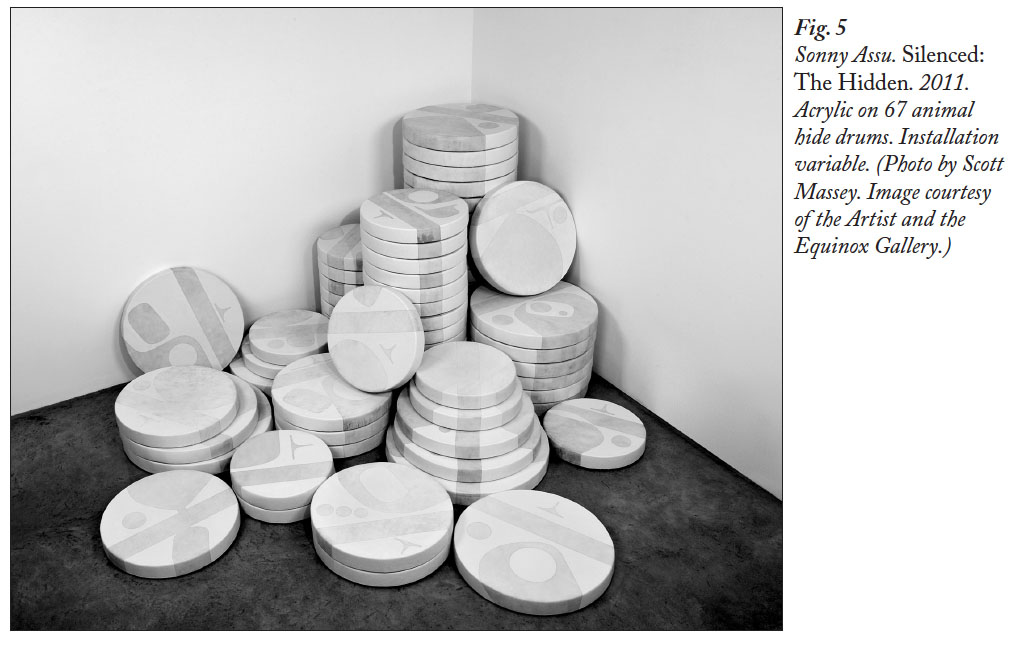 Display large image of Figure 5
Display large image of Figure 5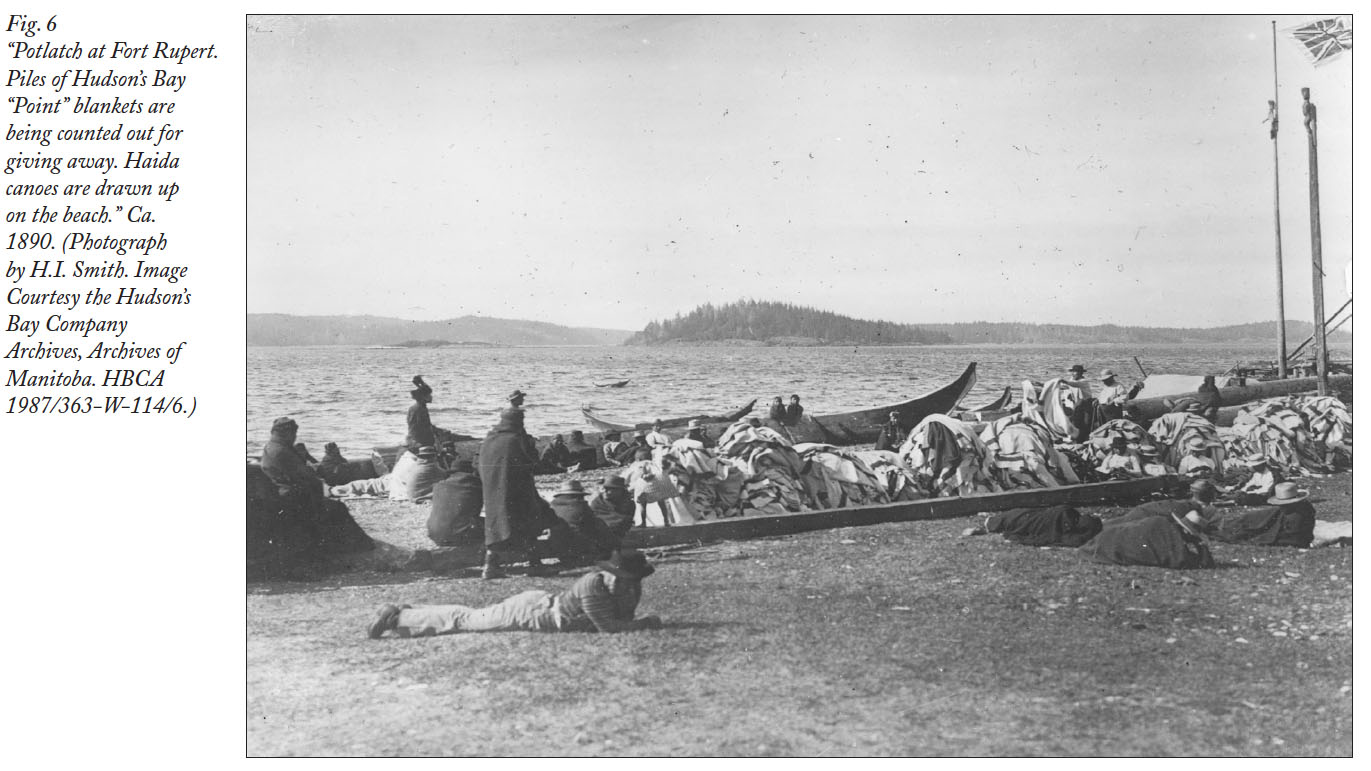 Display large image of Figure 6
Display large image of Figure 6Conclusion
12 Arjun Appadurai notes that classes of things, such as woollen blankets and textiles, “have a larger historical ebb and flow, in the course of which [their] meaning[s] may shift significantly” (1986: 34). Such meanings have been derived from the narratives that surface around woollen blankets and the ways they are circulated through popular culture. I argue that, by incorporating the woollen blanket into a work of art, artists like Sonny Assu move, or rather place, such objects and their histories into new contexts that give them new or renewed meaning. Through their artwork, artists from their cultural points of reference, make visible relevant larger, expansive and historical gesticulations that the woollen blanket has taken across time and space. Harold Tichenor once proposed that we look at woollen blankets as a “material link” (2002: 7); indeed, woollen blankets in this context link the past with the present.
13 This discussion looked purposely at how objects exist across time and space, in various locations, and how their placement into inimitable social contexts like the gallery brings to light new meanings and experiences with material objects (Becker 2008 [1982]). Through the use of woollen blankets in contemporary art, knowledge is generated and perhaps even enables social relations around material culture to become visible (Thomas 1998: ix). This case study of works by Sonny Assu in this discussion illustrates the complexity of a mutable object when considered in light of its histories and uses. As Alfred Gell argues, “human agency is exercised within the material world” and it is therefore the artists’ agency that is exercised upon woollen blankets as they have moved on a global scale into contemporary art (Gell 1998: 20).
14 As an artistic mediator (or agent), Sonny Assu possesses the force of creative interpretation that he enacts upon either woollen blankets, or representations of woollen blankets. The woollen blanket garners new meanings and values that reflect a larger commentary upon how blankets are tools, “material links” and mnemonic devices (Tichenor 2002: 7). And, most importantly, the woollen blanket is the object that allows a critical consideration of how the flow of knowledge around material culture is continually in motion.
This case study emerges from knowledge generated through two distinct but interrelated research projects: my MA thesis (2006) and my PhD dissertation, a material ethnography looking at the use of blankets in contemporary art, craft, design and indigenous regalia in Canada, the U.S. and Aotearoa New Zealand, which is currently in progress (2013). I would like to thank my past and present supervisors: In the U.K., Susanne Kuechler and Christopher Pinney; in Canada, Colleen Skidmore and Anne Whitelaw; in the U.S., Rosita Worl; and, in Aotearoa New Zealand, Bronwyn Labrum, for mentoring and encouraging my research in diverse communities over the past several years. In particular, this paper is indebted to the rich knowledge shared with me by Sonny Assu and the many artists who have generously given their time, knowledge and expertise. Thank you. I would also like to extend my gratitude to the three anonymous reviewers and the editorial feedback of Laura Bast whose profoundly rich comments have enhanced my own development as a writer.